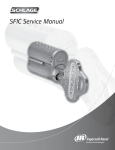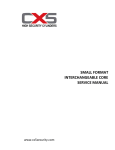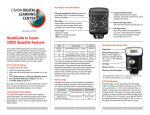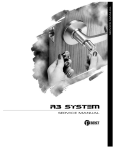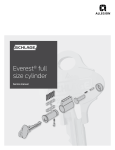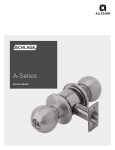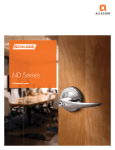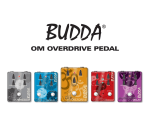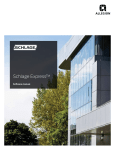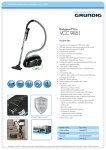Download Schlage small format cores
Transcript
Schlage small format cores Service manual Contents 6 Everest 29 Patented Key Control 6 Key Control Summary 6 Non-Patented Cores 6Locksets 6 Mortise and Rim Cylinders 7 If You Are Familiar With Pinning Best Style Cores 7 Schlage SFIC Keys 8 If You Are Not Familiar With Pinning Best Style Cores 10 6-Pin Combinating Example (Tip to Bow) 11Troubleshooting 11 Pin Lengths 12 Cutting Keys 12 12 Key Blanks Key Bitting Specifications 13 Service Equipment 13 Pin Kit Refills Schlage • SFIC service manual • 5 Everest 29 Patented Key Control Everest 29 Patented Key Control Most building owners have security problems due to the unauthorized duplication of keys. Schlage Everest 29 keys are protected by U.S. utility patents 5,715,717 and 5,809,816. Patented Undercut Groove The patented undercut groove requires a secondary milling operation to make the key blank. It is a violation of federal patent law for anyone other than Schlage to manufacture and distribute these blanks. By replacing standard cores with Everest 29 patented key cores, end users can be assured of a high level of key control. Lip for patent protection Non-Patented Cores To support key systems from other manufacturers, Schlage offers 6-pin and 7-pin uncombinated cores in the most popular IC keyways. A B C D DD E F G H J K L M N Q R TB TD These keyways are fully compatible and interchangeable with keyways of the same letter designations from Arrow, Best and KSP. Schlage and Arrow suffix the keyway letter with “B”, the Best “A” keyway is ordered as “AB”. Schlage also sells nickel silver key blanks with the Best bow shape for all non-patented core keyways. Locksets An array of Schlage deadbolts, mortise locks and key-inlever locksets are now available to accept SFIC cores. Consult Schlage sales literature and your local distributor for the latest offering of functions and finishes. Key Control Summary Most Everest 29 B Family restricted keyways are for end users who do their own key cutting. The keyway is used for each job is registered to the end user by Schlage. Everest 29 restricted key blanks, cut keys and cores are furnished only through authorized Schlage distributors and then only when the end user attaches a letter of authorization to the purchase order. Restricted items are shipped directly to the end user or a location specifically authorized by the end user. Shipping the order prevents locksmiths and distributors from having access to keys and cores without the permission of the end user. B234 and B235 restricted keyways are for locksmiths and other security dealers who cut all keys for their end user customers. Dealers must sign special key control contracts to handle these keyways. As a further deterrent to unauthorized key duplication, Schlage stamps a facility code or locksmith ID number on all keys and blanks to identify where they originated. 6 • Schlage • SFIC service manual Mortise and Rim Cylinders The Schlage SFIC mortise cylinder cams are easily changed. If You Are Familiar With Pinning Best Style Cores If You Are Familiar With Pinning Best Style Cores If you are already familiar with combinating Best style cores to the A2 System (depths 0 through 9), you will find no difference in combinating Schlage small format cores. This applies to cores with Best Keyways as well as the Everest 29 patented keyway cores. In patented keyway cores, the blocking pin near the front and to the right of the keyway checks for the lip of material on the side of the key. Schlage SFIC Keys Schlage keys use a shoulder stop against the plug face. Most other brands of SFIC keys stop at the tip. Punch-type machines for other Best style keys will not work for Schlage patented keys and vice-versa. Shoulder stop This pin does not participate in the combination of the key and it remains safely inside the core during the combinating process. Like other brands of these small format cores, the Schlage core should never be dismantled for combinating or decombinating. If you already own a different brand of specialized pin kit and tools for Best style cores, you may use them for Schlage cores with the following exceptions and cautions: 1. Do not use Arrow bottom pins because the bottom flat is smaller and may not seat properly on a zero cut when next to a 9. 2. Do not use Kaba Peaks® bottom pins as they are .003” too short for Schlage cores. 3. For security reasons, Schlage advises against using colored bottom pins. The colors can be read through the keyway with a lock scope, revealing the combination. They are also less resistant to wear than nickel silver bottom pins. Tip stop 4. Only the original Schlage 40-129 pin kit contains the plug retainer, blocking pin and blocking pin spring. The components normally do not need to be replaced, but a supply may be needed to repair a vandalized or worn core. These parts may be ordered separately if you use a different brand of pin kit. 5. Due to the location of the blocking pin, the ejector holes in the bottom of Schlage cores are all shifted by .010” toward the back of the core. This may cause problems in certain core decombinating fixtures and presses. Using any brand of ejector pin should pose no problems. Schlage reserves the right to void the warranty if the core is combinated with components that do not conform to our specifications or if keys are improperly cut. Schlage • SFIC service manual • 7 If You Are Not Familiar With Pinning Best Style Cores If You Are Not Familiar With Pinning Best Style Cores 1. Never remove the plug! These cores are designed to be top loaded. All combinating is done strictly by numbers as it is not possible to see any of the pins at the shear line. Each pin size is determined with simple addition and subtraction. There is no opportunity for trial-anderror. Top Pin Build-up Pin Master Pin Bottom Pin 2. 3. For all operating keys, have the bittings legibly and neatly written. You can get bittings from the bittings list or by gauging each key individually. Each digit of the control key should be directly over the corresponding digit of the master and change key. With the control key bitting on the top, it is helpful to draw a line under it in order not to confuse control bittings with operating bittings during the pin calculation. Unless the core is cross keyed, you normally only need three key bittings: control, TMK (top master key) and change key. In most properly designed systems, intermediate level master keys will operate automatically. This is because each digit of their bitting is usually contained either in the TMK or the change key. If any master keys must operate which have a digit not already contained in the change or TMK, that digit must be written in the appropriate position and pinned in. Insert any key, turn the plug about 90° and remove the key. Be sure the control lug remains extended, leaving a clear passage down the pin chambers to the plug surface. Check for unifor m space here Control lug extended Tur n plug about 90 4. There are two shear lines in each chamber; one for the operating keys (change, master, grand master, etc.) and one for the control key. A build-up pin is used to span the distance between the two. Its length changes based on the difference between the control key and 8 • Schlage • SFIC service manual the deepest operating key. The pin stack is illustrated below, together with the addition and/or subtraction necessary to determine each pin. All chambers use exactly the same logic and math. They differ only by the specific bitting number of each key in a given cut position. 5. Combinate one chamber completely before moving on to the next. Think of each one as a simple math problem which always has the answer of 23. Many beginners try to install all seven bottom pins, then all master pins, then all build-up pins, etc. This method may seem easier but it forces you to think through each “math problem” two or three times, rather than once. Mistakes are more common with this method. You will also never pick up any speed this way and will usually have to write down all the pins before combinating the core. Your goal should be to calculate each chamber quickly in your head as you build each stack. 6. In a master keyed core, each chamber normally has four pins. With the plug turned, you can watch the top surface of each pin stack as you complete it. The top surfaces should all line up evenly, about .050” below the top surface of the core. Paying attention to this detail lets you spot a pinning error immediately and correct it before it’s too late. BU Operating Key BU Control Key If You Are Not Familiar With Pinning Best Style Cores 7. With all chambers combinated, turn the plug back to the 12 o’clock position so all the pin stacks can fall into place. Caution: The bottom of the Schlage keyway is very wide and open. Do not turn the plug in a direction which would allow the pins to engage in the bottom of the key slot. Plastic or Rawhide Mallet add Top Pin enough to total 23 Build-up Pin 11. Spray a small amount of graphite into the keyway and run a key in and out several times to work the graphite through the core. This step is especially important for Schlage patented cores. This is the only way to lubricate the special side pin. control plus 10 minus plug total deep op. Master Pin cut minus (if any) shallow op. cut Capping Tool Cap Plug Total Spring shallow Bottom Pin operating cut Memorize: Control + 10 - Plug Total + Build Up Total Stack Height = 23 8. Add a very small amount of dry graphite into each chamber. Do not overdo this or the springs will not have room to compress properly. 9. Cap the core: a. Slide the core into the capping block. b. Install a spring into each chamber. c. Slide cap on at the top of each chamber. Pins fall into keyway Plug tur ned too far d. Chamber by chamber, press the capping tool down and strike it sharply with a plastic or rawhide mallet to press the cap all the way in and seal the chamber. Never use a metal hammer. It will eventually ruin your capping block and pin. You may prefer to install one cap and drive it into place before installing the next. The jolt from the mallet can cause loose caps to jump out of place. 10. Test all three keys (control, TMK and change key). Schlage • SFIC service manual • 9 6-Pin Combinating Example (Tip to Bow) 6-Pin Combinating Example (Tip to Bow) 5 3 1 1 0 6 2 2 9 1 3 3 4 6 6 0 2 0 0 2 7 5 A 5 AA 9 A1 Control Grand Master Master Change 8 13 4 9 11 6 12 4 16 8 10 8 2 4 2 6 2 4 1 2 1 0 0 5 Chamber 1 Shallowest operating cut is 1 (= bottom pin) Deepest minus shallowest is 2 (= master pin) Formula of C + 10 - P = BU 5 + 10 - 3 = 12 We now have 1 + 2 + 12 = 15 “units of stuff” loaded. 8 (= top pin) must be added to total 23 Chamber 3 Shallowest operating cut is 1 (= bottom pin) Deepest minus shallowest is 2 (= master pin) Formula of C + 10 - P = BU 9 + 10 - 3 = 16 We now have 1 + 2 + 16 = 19 “units of stuff” loaded. 4 (= top pin) must be added to total 23 Chamber 5 Shallowest operating cut is 0 (= bottom pin) Deepest minus shallowest is 2 (= master pin) Formula of C + 10 - P = BU 2 + 10 - 2 = 10 We now have 0 + 2 + 10 = 12 “units of stuff” loaded. 11 (= top pin) must be added to total 23 Chamber 2 Shallowest operating cut is 2 (= bottom pin) Deepest minus shallowest is 4 (= master pin) Formula of C + 10 - P = BU 0 + 10 - 6 = 4 We now have 2 + 4 + 4 = 10 “units of stuff” loaded. 10 (= top pin) must be added to total 23 Chamber 4 Shallowest operating cut is 0 (= bottom pin) Deepest minus shallowest is 6 (= master pin) Formula of C + 10 - P = BU 4 + 10 - 6 = 8 We now have 0 + 6 + 8 = 14 “units of stuff” loaded. 9 (= top pin) must be added to total 23 Chamber 6 Shallowest operating cut is 5 (= bottom pin) Deepest minus shallowest is 4 (= master pin) Formula of C + 10 - P = BU 7 + 10 - 9 = 8 We now have 5 + 4 + 8 = 17 “units of stuff” loaded. 6 (= top pin) must be added to total 23 10 • Schlage • SFIC service manual Troubleshooting Troubleshooting If any key fails to operate the core you’ve just combinated, review the bittings and try to ascertain where the mistake may be. Hold the core upside down and place the ejector tool into the hole of the chamber you want to empty. Using a light plastic mallet, tap the ejector tool until it forces all material out of the pin chamber. Test all key(s) again. Ejector Tool Pin Lengths Bottom Pins 0A = .110” 1A = .1225” 2A = .135” 3A = .1475” 4A = .160” 5A = .1725” 6A = .185” 7A = .1975” 8A = .210” 9A = .225” Master, Build-up and Top Pins If the problem persists, take your next best guess of where the error is a repeat with another chamber. When all keys operate, you know that the remaining chambers are combinated correctly. Recombinate the empty chambers. This technique is also used when it is necessary to decombinate the core for rekeying. If you find combinating difficult, we recommend completely finishing one chamber at a time, including the capping process, leaving the remaining chambers empty. This allows you to test all keys chamber by chamber until you build up enough accuracy and confidence to handle all chambers at once. If keys fail to operate smoothly and you are positive you have cut the keys and pinned the core correctly, your key machine may be out of adjustment or pins may have gotten mixed up in your pin kit. The A2 system pin lengths and key bitting specs are shown on these pages. You will need calipers or a micrometer to check your pins and keys against the specs. Non-patented cores may be combinated to A3 or A4 system specifications, but these would be non-Schlage key systems and are not within the scope of this manual. 2B = .025” 3B = .0375” 4B = .050” 5B = .0625” 6B = .075” 7B = .0875” 8B = .100” 9B = .1125” 10B = .125” 11B = .1375” 12B = .150” 13B = .1625” 14B = .175” 15B = .1875” * 16B = .200” 17B = .2125” * 18B = .225” 19B = .2375” *Not used in pure 2-step progression. Schlage • SFIC service manual • 11 Cutting Keys Cutting Keys The Schlage 40-071 is a special version of the Blue Punch key machine for the Everest 29 patented SFIC keys. For service on this machine, contact Pro-Lok® at (714) 6330681, fax (714) 633-0470. Key Bitting Specifications Depths 7 .988" 0 = .3187” 6 .838" 5 .688" 1 = .3062” 4 .538" 2 = .2937” 3 .388" 3 = .2812” 2 .238" 4 = .2687” 1 .088" 5 = .2562” .054 6 = .2437” 7 = .2312” 8 = .2187” 9 = .2062” 1 1.096" To cut Schlage keys on a rotary cutter code machine, it may be necessary to modify or replace the vise jaw for reliable gripping. Contact your key machine manufacturer directly. Since the Everest 29 patented core is designed to replace cores by Best, Arrow and others, Schlage’s key cuts are read and written Tip to Bow. This is the opposite of other Schlage keys, but standard for small format IC. 2 .946" Code Card 3 .796" 90˚ .052 .056 Everest SFIC Key section Key Blanks Schlage began to phase in the Everest 29 bow (pictured above) beginning in 2002. Earlier Everest 29 SFIC key blanks had the Classic Schlage key bow. 12 • Schlage • SFIC service manual for HPC 1200 CM Code Machine 5 .496" 35-400 Facility code or locksmith ID C116 4 .646" 6 .346" 7 .196" Service Equipment Service Equipment NOTE: If you already own comparable Best style service equipment by other manufacturers, you do not need to invest in new equipment other than the key machine for Everest 29 patented keyway cores. Key Machine for Everest 29 B Family Keys Only 40-071 A2 System Pin Kit 40-071 Pin Kit Refills 100/pack Bottom Pins Master, Build-up and Top Pins 0A 34-800 2B = 34-902 = 34-903* = 1A = 34-801 3B 2A = 34-802 4B = 34-904 3A = 34-803 5B = 34-905 4A = 34-804 6B = 34-906 5A = 34-805 7B = 34-907 6A = 34-806 8B = 34-908 7A = 34-807 9B = 34-909 8A = 34-808 10B = 34-910 9A = 34-809 11B = 34-911 12B = 34-912 13B = 34-913 14B = 34-914 15B = 34-915* 16B = 34-916 17B = 34-917* 18B = 34-918 19B = 34-919* * Not used in Schlage systems A2 System Key Gage 40-128 Capping Block 40-137 9 8 7 6 5 4 3 2 1 0 Capping Pin 40-138 Ejector Pin 40-136 Schlage • SFIC service manual • 13 About Allegion Allegion (NYSE: ALLE) creates peace of mind by pioneering safety and security. As a $2 billion provider of security solutions for homes and businesses, Allegion employs more than 7,800 people and sells products in more than 120 countries across the world. Allegion comprises 23 global brands, including strategic brands CISA®, Interflex®, LCN®, Schlage® and Von Duprin®. For more, visit www.allegion.com. © 2014 Allegion 008230, Rev. 06/14 www.allegion.com/us
















